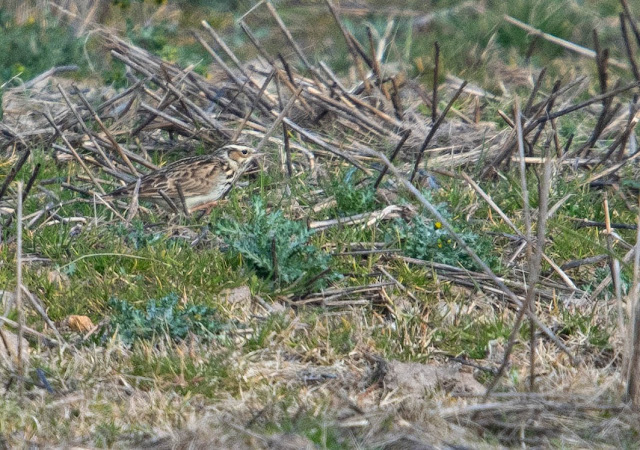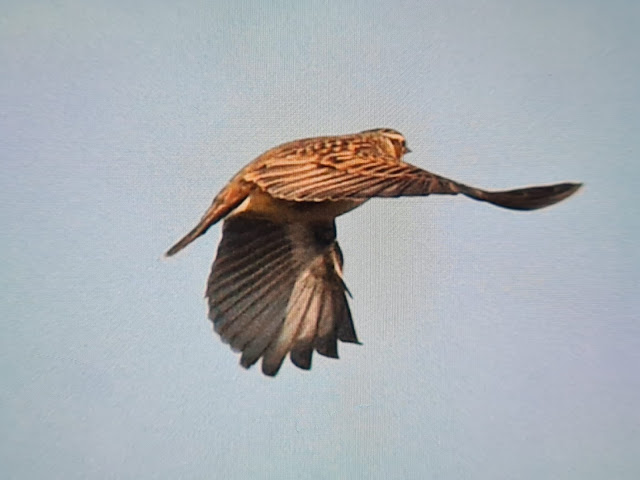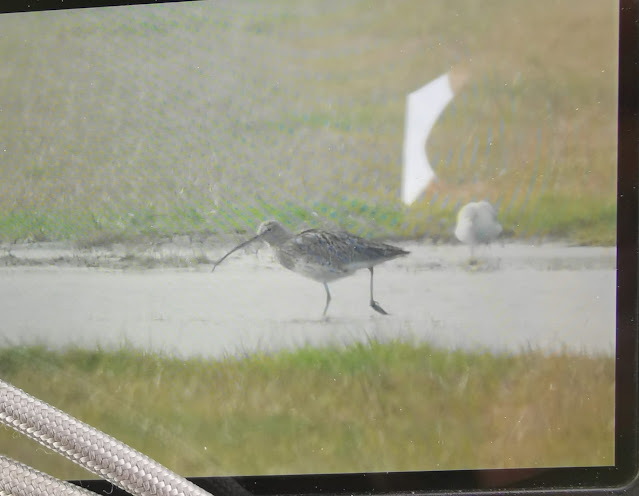Although a somewhat quiet month, March was not without avian interest. On the 2nd a single Snow Bunting was on the beach, and on the 3rd a Peregrine sat in the field opposite Bramble Gap long enough for Mick to alert tardy yearlisters (Sean) about it. Geese were melting away steadily, and only 8 Pink-footed Geese were in the field alongside it. A short poor seawatch on the 5th produced a Pintail for Pat, and several pairs of Ringed Plover were taking up territories on the beach. Goodness knows if they'll have any success this year with so many off-lead dogs everywhere. However, English Nature are employing a summer warden for the dunes and beach this year, to complement the RSPB's Little Tern efforts, and part of his job is to try to educate (in a non-confrontational and friendly way) dog walkers about the harm off-lead dogs do in the breeding season. We wish him every success!
The Dunlin numbers on the flooded field next to Commissioner's Dyke fluctuated up again on the 5th, with around 70 present, and beyond them in the heat haze 7 Whooper Swans (4 adults and 3 immatures) grazed alongside the Mutes. Several pairs of Gadwall were also in the same area during this time, and Red Kites were a daily occurrence on the patch too.
On the 9th Pete was walking up Low Road when he noted three short-tailed passerines take off from a field. He thought perhaps they might have been Woodlarks but his mind was focused on bryophytes and he continued on his walk up to the ruined church without thinking any more about them. A little later he met Sean coming back from Commissioner's and they walked back down Low Road. Sean saw three passerines fly up from nearly the same place and at that point Pete told him of the earlier sighting. This time however they were found on the ground a little further along and confirmed as Woodlarks. They hung around for the rest of the day allowing all of us to see them.
The next week was largely quiet, although Siskins were on the move (all going south, as birds often do here in the spring), and both winter thrushes were seen regularly in small numbers. On the 12th Pat saw a Merlin from the concrete track and Mick saw a White Wagtail at Commissioner's. The wintering Green Sandpiper was also still frequently showing very well in the same area, and Mistle Thrushes had started singing in several places on the patch.
Towards the end of the afternoon of the 14th an amazing migration spectacle began to take place in Winterton, and indeed all along the coast of east Norfolk. Blackbirds were on the move... There were lots gathered in the paddocks along Low Road, and in the air more and more seemed to be appearing until it reached a point when at all heights, wherever you scanned, you could see parties of Blackbirds, from just over the rooftops to barely visible almost in the high clouds. There were many hundreds of birds passing, mainly going south (as usual!) but there seemed a smaller number heading in almost every direction. We later found that the predominant direction across Norfolk for this incredible event was north-east, so again Winterton birds were bucking the trend. The movement primarily took place in the last hour and a half before dark, and must have involved several thousand birds. That's what patch birding is all about!
Over the next few days Starlings, Chaffinches and Siskins moved south each morning in significant numbers, with Redwings and Fieldfares also moving through in smaller numbers. A ringtail Hen Harrier was seen fairly regularly, and Mick saw another Woodlark in flight south over Bramble Gap on the 15th. A non-birding local reported the first Wheatear of the year on the same day, at the Chalet Park, and Sean sound-recorded a Water Rail over his garden at midnight.
On the 16th Colin found a Grey Wagtail in the newly dug dyke next to the devastated hedge along Low Road, and although it flew off, it had the grace to return about an hour later and allow several more of us to get it on our yearlists - a very tricky bird to make sure of these days...
On the 17th Barry saw two Black Redstarts in the valley and 16 Snow Buntings on the beach, while Mick and Tim saw a Great White Egret, 4 Red Kites and a Shoveler from Bramble Gap. Black Redstarts were seen pretty regularly from this point to the end of the month by most of us, generally around the Hermanus.
On the 18th Mick saw a Merlin whizz successfully through the Starling flock and land in the field with its prey. He also had a Blackcap in the Low Road paddocks. Quite a few Woodcock seemed to be arriving around this time, including one that Pete flushed off the allotments. On the 19th Pat saw this male Hen Harrier at Bramble Gap.
On the 19th Chris, our regular visitor, was up from Bedfordshire and casually told us he'd had a singing Cetti's Warbler in a ditch along Low Road, which, although a Winterton tick for him, was, he assumed, a regular bird for us locals... In fact it's a real rarity on the patch and when we found out we all shot up to search for it, but alas unsuccessfully!
On the 20th Barry reported two Firecrests on private property, and Manyard a Red-necked Grebe flying north just beyond the surf. On the 21st Barry found another two Woodlarks in one of the paddocks, but they did not hang around like the earlier Low Road birds.
A smattering of Curlews have been seen (or heard) in flight this year, but one found by Sean walking about in the Commissioner's field on the 21st was the first on the deck, allowing Pat to twitch it for his yearlist when he got home from work!
On the 23rd Barry found another Firecrest, this time in the valley, on a classic date for this species here, but annoyingly it melted away and couldn't be found a few minutes later. It looks like the Firecrest early spring window has closed with only Barry managing to see any. And last year there was none in the autumn...
On the 24th Tim found a Wheatear in the farmland opposite Bramble Gap, and later Sean found another in the North Dunes and took the customary 'first Wheatear' photo below. It hung around long enough for several others of us to see it too. What a great pleasure it is to see these birds when they arrive.
Chiffchaffs also started to arrive and sing in small numbers across the patch around this time.
On the 25th Sean saw a White Wagtail in the horse paddocks along Low Road, and on the 28th another Black Redstart in the valley, this time much further south by the public steps. The next day he also saw a Brambling in the valley, and Mick discovered patch gold with 4 Canada Geese in the Commissioner's field, which hung around long enough for most of us to see them. There were also 11 Ringed Plover there and a latish lone Whooper Swan in the field behind them.
At the end of March the collective patch year list stands at 128. This time last year we were on 140, with quite a few more Spring migrants already arrived, so let's hope this April brings a nice southerly wind or two, and we don't have a terrible prolonged cold spell again. Happy patch birding everyone!


.jpeg)









